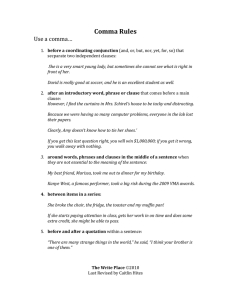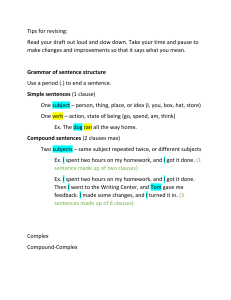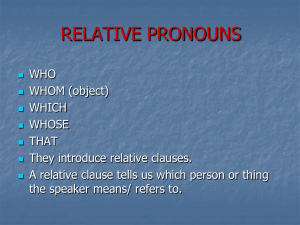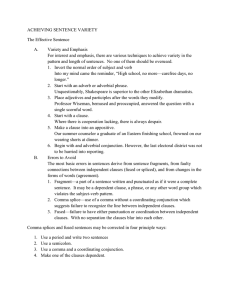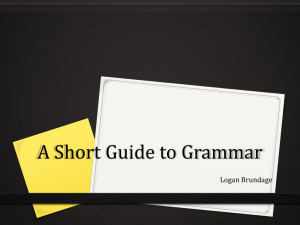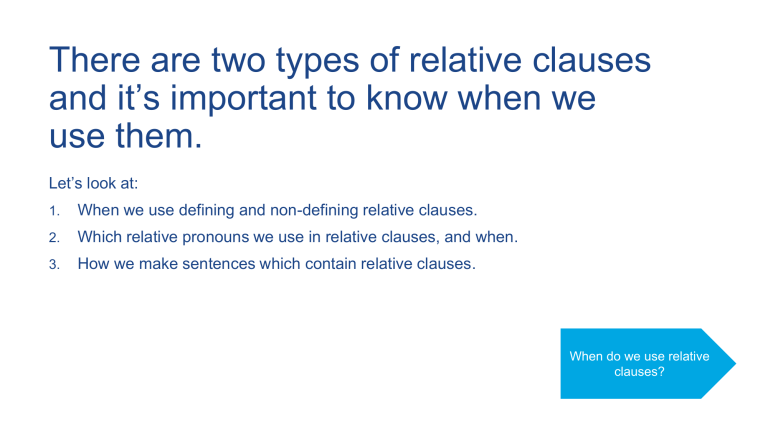
There are two types of relative clauses and it’s important to know when we use them. Let’s look at: 1. When we use defining and non-defining relative clauses. 2. Which relative pronouns we use in relative clauses, and when. 3. How we make sentences which contain relative clauses. When do we use relative clauses? Function: When do we use relative clauses? We use relative clauses to give more information about a person, place, object, situation, etc. There are two types – defining and non-defining relative clauses. Match them to the pictures. Look at these sentences. They have the same relative clause: ‘which was red’. In the first sentence with the comma, the relative clause isn’t necessary to understand which t-shirt the girl is talking about – it’s just extra information. In the second sentence without the comma, the relative clause is necessary in order to define which t-shirt the girl bought. 1. I bought the cheapest t-shirt, which was red. 2. I bought the cheapest t-shirt which was red. Function: When do we use relative clauses? Defining relative clauses: Information which is necessary to define which object, person, place, etc. we are talking about. Here, the relative clause, which was red, is necessary. She didn’t buy the cheapest t-shirt (the purple one). She bought the cheapest red t-shirt. I bought the cheapest t-shirt which was red. Defining relative clauses have NO comma. Nondefining relative clauses have a comma. Non-defining relative clauses: Information which isn’t necessary to define which object, person, etc. we are talking about. It’s just extra information. I bought the cheapest t-shirt, which was red. Here, the relative clause, which was red, isn’t necessary. We know that she bought the cheapest t-shirt. The fact it is red is just extra information. Relative pronouns… Function: What about relative pronouns? Relative pronouns connect the relative clause to the rest of the sentence. We use different relative pronouns depending what we are describing. Look at the examples and complete the table with one of the relative pronouns in bold. It’s the restaurant where I had my birthday party. He’s the boy who I walk to school with. people who things/animals which places where times when possessions whose It’s the dog whose owner is sitting over there. I’ll always remember the day when I broke my arm skiing. I read a wonderful book which was set in New York. Function: What about relative pronouns? The relative pronouns connect the relative clause to the rest of the sentence. We use different relative pronouns depending what we are describing. It’s the restaurant where I had my birthday party. people He’s the boy who I walk to school with. It’s the dog whose owner is sitting over there. who things/animals which places where times when possessions whose I’ll always remember the day when I broke my arm skiing. I read a wonderful book which was set in New York. In defining relative clauses, we can also use that instead of who or which. We cannot use that after a comma with non-defining relative clauses. Practice activities Look at the sentences. They all have errors. Correct them and justify your answers. 1. Last week, I went to see my brother Tom who lives in London. Last week, I went to see my brother Tom, who lives in London. We know which brother he is talking about (Tom), so this is a non-defining relative clause and needs a comma. 2. She is my neighbour that mother is really famous. She is my neighbour whose mother is really famous. 3. Jack is the boy where I study with on Saturdays. Jack is the boy (who) I study with on Saturdays. 4. This is my new baby sister, that turns one month old tomorrow. This my new baby sister, who turns one month old tomorrow. 5. Is that the car whose you sold last year? Is that the car (which/that) you sold last year? 6. This is the photo, which I told you about yesterday. This is the photo (which/that) I told you about yesterday. This is a defining relative clause (the information is necessary to know which photo we are talking about), so we don’t use a comma.
